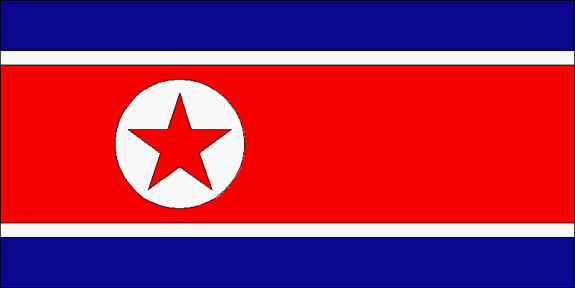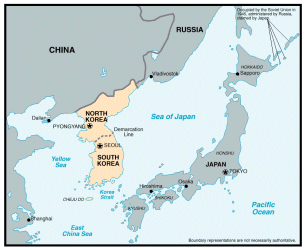





 The Korean Peninsula protrudes southward from the Asian mainland separating the Yellow Sea (West Sea) to the west from the East Sea (Sea of Japan) to the east. The Peninsula is roughly 346 km (215 mi) wide at its broadest point (approximately 38�10'N), roughly 169 km (105 mi) at
its narrowest point (approximately 39�20'N), and approximately 965 km (600 mi) long. The northern-most point of the peninsula is located on the Chinese border at approximately 43�N (about the same latitude as Buffalo, New York). The western-most point on the peninsula is located at 124�40'E on the Yellow Sea, and the eastern most point on the peninsula is located at 129�35'E on the East Sea (Sea of Japan)/Korea Strait (Straits of Tsushima). The total land area for North Korea is 120,410 km (46,490 mi), or slightly smaller than Mississippi.
The Korean Peninsula protrudes southward from the Asian mainland separating the Yellow Sea (West Sea) to the west from the East Sea (Sea of Japan) to the east. The Peninsula is roughly 346 km (215 mi) wide at its broadest point (approximately 38�10'N), roughly 169 km (105 mi) at
its narrowest point (approximately 39�20'N), and approximately 965 km (600 mi) long. The northern-most point of the peninsula is located on the Chinese border at approximately 43�N (about the same latitude as Buffalo, New York). The western-most point on the peninsula is located at 124�40'E on the Yellow Sea, and the eastern most point on the peninsula is located at 129�35'E on the East Sea (Sea of Japan)/Korea Strait (Straits of Tsushima). The total land area for North Korea is 120,410 km (46,490 mi), or slightly smaller than Mississippi.
Korea is located in the East Asian Monsoon belt. Seasonal monsoon winds affect Korea's weather throughout the year. The Southwest Monsoon blows in from the south and southeast during the summer, bringing hot, humid weather. The cold, dry, Northwest Monsoon blows in from the north and northwest during the winter, bringing cold weather. Korea's massive mountains protect the peninsula's east coast from the winter monsoon, though occasional heavy snows can fall along the eastern mountain ranges. In determining the effect of surface winds, direction is the most signif-icant criteria. During the Northwest Monsoon (November-March), the effects of nuclear, biological, and chemical (NBC) warfare to the south are heightened.
After the Chinese Communist Forces (CCF) intervened in the war at the end of October 1950, FEAF B-29s and Navy aircraft attacked Yalu River bridges throughout mid-November 1950 in attempt to isolate Chinese forces on the battlefield. On 05 November FEAF was ordered to destroy every means of communication and every installation, factory, city, and village starting southward from the Yalu. The use of incendiaries on the cities and towns was authorized in order to destroy shelter that would be used by troops coming in from Manchuria. In two weeks, fire attacks destroyed large portions of 10 cities immediately south of the Yalu. On 5 December, the bridge attacks were suspended, but by this time the Yalu was frozen over in many places and enemy engineers were building pontoon bridges across the Yalu at critical points.
After 13 April 1951, medium bombers began a priority neutralization of all North Korean airfields. This activity continued to get main emphasis until the end of April, by which time the Chinese gave up the repair effort. For a time the B-29s continued bombing targets in northwest Korea by day, but when MiG-15s shot down five Superfortresses in a week in October 1951, the big bombers began attacking only at night. Three interdiction operations, two named STRANGLE and another called SATURATE, tried to paralyze the enemy's transportation system upon which he relied for supplies. Weather and an inability to execute sustained night attacks thwarted these efforts.Much more successful was the campaign to employ air power to pressure the Chinese into accepting an Armistice satisfactory to the United States. Attacks in July 1952 on four hydroelectric generating complexes at Suiho, Chosin, Fusen, and Kyosen opened the "pressure" campaign. The power installations on the Korean side of the Yalu and the power dams on the river itself had no military significance. Their destruction, if accomplished, would necessarily therefore be a political matter. Instructions to refrain from destroying these installations had been widely publicized as evidence of the United Nations peaceful intent toward countries north of the Yalu. The raids were spectacularly successful; North Korea experienced a nearly total loss of electric power for two weeks and never regained its former level of generating capacity before the end of the war. Manchuria, too, suffered the loss of a quarter of its supply of electricity. These attacks did not result in the quick peace agreement that the air planners had hoped for, and bombing under the air pressure strategy continued.
This "air pressure" campaign was perhaps a key factor in finally ending the war. Bomber Command directed its efforts against communications centers, manufacturing facilities, and supply concentrations to undermine the North Korean regime by inflicting economic damage that would become a drain on peacetime recovery. On 11 July 1952 the Air Force launched a concentrated strike on Pyongyang under the name "Operation Pressure Pump." The war's largest air raid came on 29 August 1952, when FEAF and carrier planes bombed Pyongyang in a 1,403-sortie assault.
In May 1953, FEAF planes shattered three of North Korea's 20 irrigation dams. The resulting floods wiped out roads, railroad tracks, and thousands of acres of rice fields. Even though the enemy soon repaired the damage, they had to reduce the water levels in all the dams so as to prevent flooding in case of attack. These precautions, however, also reduced the water available to the remaining rice crops.
During the war, FEAF units flew 720,980 sorties and delivered 476,000 tons of ordnance. For these numbers FEAF estimated it had killed nearly 150,000 North Korean and Chinese troops and claimed the destruction of more than 975 aircraft, 800 bridges, 1,100 tanks, 800 locomotives, 9,000 railroad cars, 70,000 motor vehicles, and 80,000 buildings. The B-29s had flown 20,448 sorties (10,125 by day and 10,323 at night), and had dropped 168,368 tons of bombs. Korean People's Army (KPA) losses in the Korean War, called the Fatherland Liberation War by North Korea, totaled more than half a million persons, although North Korea has not released figures. The war also resulted in the virtual destruction of North Korea's economy and infrastructure. By the time the armistice was signed in 1953, North Korea had been devastated by three years of bombing attacks that had left almost no modern buildings standing. Both Koreas had watched as their country was ravaged and the expectations of 1945 were turned into a nightmare. Furthermore, when Kim's regime was nearly extinguished in the fall of 1950, the Soviet Union did very little to save it--China picked up the pieces. The Soviet Union, China, and East European countries provided reconstruction assistance.The basic goal of the Three-Year Plan, officially named the Three-Year Post-war Reconstruction Plan of 1954-56, was to reconstruct an economy torn by the Korean War. The highest priority was developing heavy industry, but an earnest effort to collectivize farming also was begun. At the end of 1957, output of most industrial commodities had returned to 1949 levels, except for a few items such as chemical fertilizers, carbides, and sulfuric acid, whose recovery took longer.
